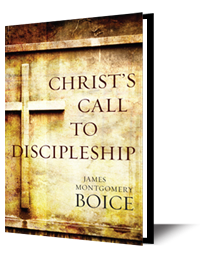Law and Grace - Part 3
Theme: Our Old and Our New Life
This week’s lessons teach that God’s grace, rather than leading to sin or even an indifferent attitude about it, actually leads to a holy life because we are now dead to sin and have been made alive in Jesus Christ.
Scripture: Romans 6:1-14
In yesterday devotional we looked at three mistaken ideas for the meaning of “dying to sin.” Today we begin by looking at two others.
The Christian cannot continue in sin because he has renounced it. This view carries no less weighty a name in its favor than that of Charles Hodge, a former great theology professor at Princeton Theological Seminary. Hodge notes the full aorist tense of the verb “died,” observing rightly that it refers to a specific act in our past history, and he sees that act as our renunciation of sin in order to follow Christ. This is a good interpretation for two reasons:
- It recognizes the full force of the aorist verb “died.”
- What it says is true.
Coming to Christ as Savior does involve a renunciation of sin; to renounce sin and to continue in it at the same time is a contradiction. If we had no other possible interpretations to go on, this would be an attractive explanation.
But there is a problem. In Hodge's interpretation "dying to sin" is something we do. It is our act, the act of accepting Christ. However, in Paul's development of the idea, "dying to sin" is not something we do or have done, but rather something that has been done to us. It is the same as our being joined to Jesus Christ, which he is going to talk about in a moment under the figure of baptism. We did not join ourselves to Christ. Rather we were in Adam, and then God by his grace took us from that position and transferred us into the kingdom of his Son. It is because of that work that we are no longer to continue in sin, that doing so is unthinkable.
The Christian has died to sin's guilt. This last mistaken understanding of the phrase “we died to sin” is Robert Haldane's. He sees it as having nothing to do with sanctification but rather with one result of justification, death to sin's guilt. What Haldane says is undoubtedly true as far as it goes. The justification of the believer has freed him or her from the guilt of sin, and it is true that in this sense the person has indeed died to it. As far as the guilt of sin and its resulting condemnation are concerned, sin no longer touches the Christian.
But that does not go far enough. True, we have died to sin's guilt. But what Paul is dealing with in this chapter is why we can no longer live in it. If all he is saying is that we are free from sin's condemnation, the question of verse 1 remains unanswered.
It is obvious that, having rejected five important interpretations of the phrase “we died to sin,” including no less weighty interpretations than those of Charles Hodge and Robert Haldane, I must have a better view in mind—presumptuous as that may seem. But I think that is exactly what I do have, though I have certainly not invented it. It is expressed in various forms by such scholars as F. Godet, John Murray, D. Martyn Lloyd-Jones, and John R.W. Stott.
In a short study titled Men Made New (Baker, 1984), Stott begins by noting that there are three verses in Romans 6in which Paul uses the phrases “died to sin” or “dead to sin.” It is in verses 2, 10, and 11. In two of those instances, the first and the last, the reference is to Christian men and women. In the second of those verses the reference is to Christ. It is a sound principle of interpretation that whenever the same phrase occurs more than once in one context it should be taken in the same way unless there are powerful reasons to the contrary. And if that is so, then the first question to ask in order to understand how we have died to sin is how Christ himself died to it. How did Jesus Christ die to sin?
The first answer we are inclined to give is that he died to sin by suffering its penalty. He was punished for our sin in our place. If we carry that through, we will come out near the position of Robert Haldane, thinking of justification only and of our death to sin's guilt.
But I want you to notice two things. First, the reference to Jesus' death in verse 10 does not say that he died for sin, though he did, but that he died to sin—the exact thing that is said of us. That seems to be a different idea. Second, Paul's statement does not say only that Christ "died to sin" but adds the very important words “once for all.” The full verse reads, “The death he died, he died to sin once for all; but the life he lives, he lives to God.” This means that as far as sin is concerned, Jesus' relationship to it is finished. While he lived upon earth he had a certain relationship to it. He had come to die for sin, to put an end to its claims upon us. But now, having died, that phase of his life is past and will not be repeated. Verse 9, which leads into verse 10, says exactly that: “We know that since Christ was raised from the dead, he cannot die again, death no longer has mastery over him.”
Now apply this understanding of “death to sin” to the other two instances, which refer to us. How? By realizing that, as a result of our union with Christ in his death and resurrection, that old life of sin in Adam is past for us also. We can never go back to it. We have been brought from that old life, the end of which was death, into a new life, the end of which is righteousness. Therefore, since this is true of us, we must embrace the fact that it is true and live for righteousness.
Stott thinks of our biography being written in two volumes. Volume 1 is the story of the old man, of me before my conversion. Volume 2 is the story of the new man, of me after I have been made a new creation in Christ. Volume 1 of my biography ends with the judicial death of the old self. I was a sinner. I deserved to die, and I did die in the person of Jesus with whom I have become one. Volume 2 opens with my spiritual resurrection. I am now alive in him.
Study Questions:
- List and briefly explain the last two misunderstandings of the idea of “dying to sin.”
- Explain the better meaning of “dead to sin.” How did Jesus Christ die to sin? What does this mean for us?
Reflection: Think about what John Stott said about the Christian’s biography being written in two volumes. What was your life like in the first volume? What is it now like in the second? Are there any things in your life today that you know look more like the first volume, before you were converted? Praise the Lord for what he has done for you in this second volume of salvation. But also pray for his grace to help you rid yourselves of those things that you know must not be part of your life now that you are in Christ.
Think and Act Biblically from James Boice is a devotional of the Alliance of Confessing Evangelicals. It is supported only by its readers and gracious Christians like you. Please prayerfully consider supporting Think and Act Biblically and the mission of the Alliance.


















